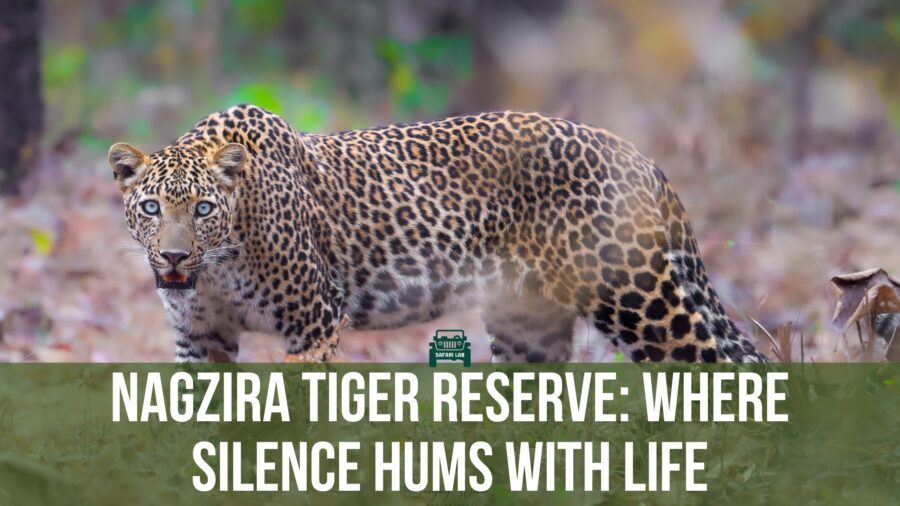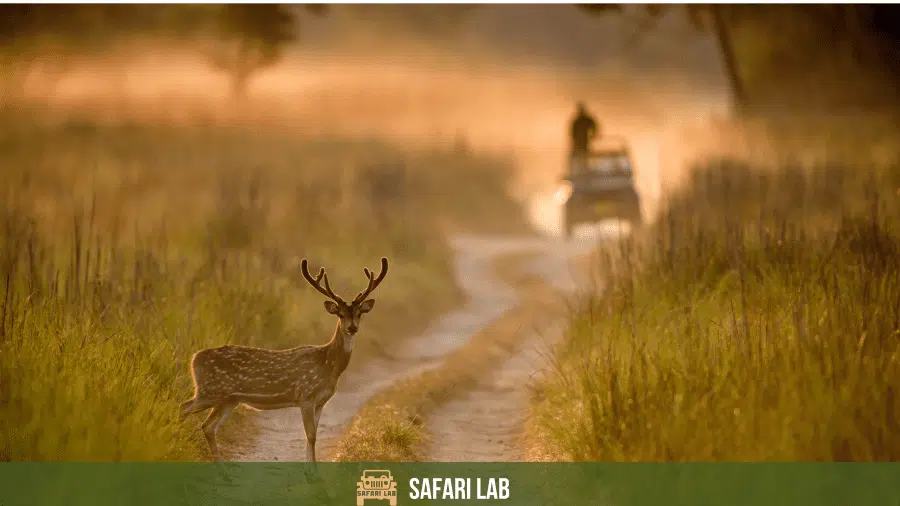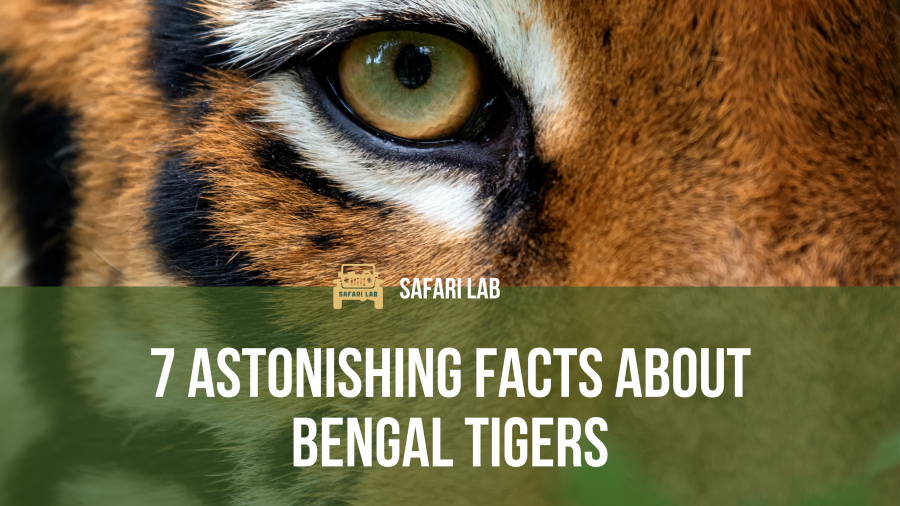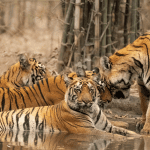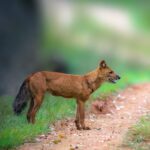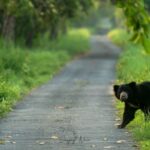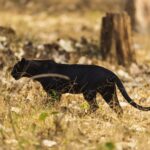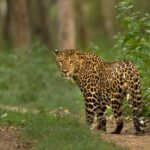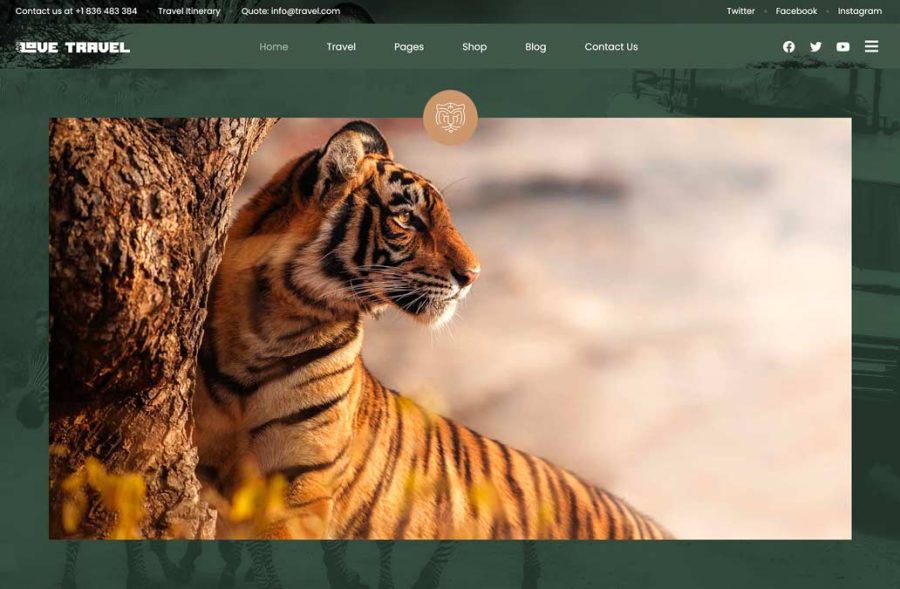Nagzira Tiger Reserve, even the name seems to rustle like dry teak leaves underfoot—whispered by the wind across a sleeping forest. Tucked deep within the Satpura-Maikal landscape, at the junction of Maharashtra’s Gondia and Bhandara districts, this sanctuary remains one of India’s most enigmatic wild spaces. It is not grand like Kanha, nor thronged like Tadoba. Instead, Nagzira reveals itself slowly—layer by layer—like the undergrowth parting for a tiger’s passing.
Here, among undulating hills and shallow valleys, time appears reluctant to move. Sal and bamboo jostle for light; ghost trees shimmer in the early mist. A sloth bear lumbers across a dry streambed. Langurs raise an alarm—sudden, sharp. Somewhere, unseen yet deeply felt, the jungle holds its breath.
It is, without hesitation, one of our favourite forests in central India. Not for the frequency of sightings, but for the theatre of atmosphere it stages—subtle, immersive, and hauntingly beautiful.
What is Nagzira Tiger Reserve?
Part of the Nawegaon–Nagzira Tiger Reserve, this sanctuary covers nearly 153 square kilometres—small by Indian standards, yet remarkably rich. Over 220 bird species take wing here. Forty mammal species leave tracks in its dusty trails.
Among them: the Gaur, India’s massive wild ox; the nimble dhole, red as the forest floor in March; and of course, the tiger—the elusive apex that shapes every rustle, every gaze.
But Nagzira’s story is more than its wildlife. It is also told in its gates—Chorkhamara, Pitezhari, Mangezari, and the newer Umarzari—each one a threshold not just to terrain, but to time. For those who enter with patience, and a reverence for silence, the forest gives up its secrets: a tigress with fresh cubs along the Tiger Trail, a leopard melting into the lantana on Budda Buddi, a herd of chital grazing untroubled by the rumble of a distant jeep.
This is a forest not to be consumed, but understood.
In the chapters ahead, we will walk its trails, listen to its predators, trace the lives of tigers known only as T1, T2, T3, and T4—each a sovereign in their domain. We’ll enter through the gates, examine the safari paths etched into dust and stone, speak of its guest houses and forest lodges, and listen closely to those who know this land best—its guides, trackers, and villagers.
In Nagzira, the jungle does not perform. It simply is.
The Gates of Nagzira: Portals to a Vanishing Wilderness
Nagzira does not declare itself at once. To enter is to step across thresholds that seem drawn by the forest itself—each gate, a whispered invitation to explore a different mood of the jungle. Four main entry points grant access to this wild mosaic, each tied not only to location, but to local history, logistics, and the rhythm of human-animal interactions.
Chorkhamara Gate (Gate 1 – Old Nagzira)
This is the sanctuary’s best-known access point, and for good reason. Situated near the small town of Chorkhamara, it is the principal gateway into Old Nagzira, the core zone of the sanctuary and also New Nagzira, also called Gate 2. Most safaris begin here. The trails fanning out from this gate—Tiger Trail, Wakda Bheda, Gaur Galli, Chital Marg, Satmodi—form the spine of the tourism landscape. Forest department accommodations and booking counters are stationed nearby, and guides here are often veterans, their knowledge embedded in generations of local experience.
Chorkhamara Gate 2 (New Nagzira)
Chorkhamara Gate 2 is the newer part of the forest leading into New Nagzira. This area was initially a compartment of the Maharashtra Forest Development Corporation (FDCM). But it was in Less trafficked, this side of the reserve offers quieter forests, newer trails, and often, more intimate sightings. While infrastructure is still developing, sightings of resident tigers like T4 (Alisha) and her cubs are becoming frequent. The terrain here is more open in parts, with bamboo-dominated corridors leading to waterholes like Risada Talav and tracks such as Gaykhori and Bison Road.
Pitezhari Gate
Preferred by those arriving from Bhandara or Sakoli, Pitezhari is an alternate access point into Old Nagzira. The drive in from this side is scenic, often through village roads flanked by sugarcane and mahua groves. Safari entry is regulated similarly to Chorkhamara, and visitors booking through this gate should ensure timing coordination, as the road from Sakoli to Pitezhari is narrower and more rural.
Mangezari Gate
On the eastern periphery, Mangezari serves both as a functional entry for management and a quiet tourism gate. Far fewer jeeps pass through here. For those seeking solitude, birdwatching, or early morning light falling through untouched Teak groves, Mangezari delivers a different kind of safari—a slower, more meditative one. It is also the gate closest to parts of the corridor linking Nagzira to Nawegaon, where lesser-seen wildlife like pangolins and mouse deer have been recorded.
The Nagzira Wildlife Sanctuary Landscape: A Canvas of Many Hues
Nagzira Wildlife Sanctuary, a verdant jewel nestled in Maharashtra’s landscape, unfolds a tapestry of trails that meander through its diverse terrains. Each path offers a unique narrative, inviting explorers to immerse themselves in the sanctuary’s natural splendor. Let’s embark on a journey along these trails, beginning with the renowned Tiger Trail.
Tiger Trail
As dawn’s first light filters through the dense canopy, the Tiger Trail awakens, offering a pathway into the heart of Nagzira’s wilderness. This trail, aptly named, winds through a mosaic of dry deciduous forests dominated by teak and bamboo, creating an ideal habitat for the elusive Bengal tiger. Traversing this path, one might encounter not only the majestic tiger but also leopards, sloth bears, and an array of deer species. The trail’s undulating terrain and proximity to water sources make it a favored route for predators and prey alike, providing visitors with a heightened chance of witnessing the intricate dance of survival.
Bison Road (Gaur Galli): The Undulating Realm
Carving through Nagzira’s hilly terrain, Bison Road, locally known as Gaur Galli, remains one of the primary safari tracks. This rugged stretch is punctuated by multiple waterholes, serving as clandestine meeting points for sloth bears and tigers. The dense foliage and undulating landscape create a secluded corridor, where the keen observer might glimpse the elusive inhabitants that navigate this challenging terrain. It is quite popular for Sloth Bears, Leopards and Tiger activity. During our last tour, we found T4 and her 3 cubs in this area feasting on a Gaur Kill. How apt 😊
Ghatmara
The Ghatmara trail introduces travelers to Nagzira’s hilly terrains, characterized by rocky outcrops and steep inclines. This challenging path rewards the intrepid with panoramic vistas and encounters with wildlife adapted to the rugged landscape. Sambar deer and wild boars navigate these slopes with ease, while the occasional sighting of a leopard adds an element of thrill. The trail’s elevation offers a unique perspective of the sanctuary, showcasing the seamless blend of forest and topography.

Satmodi (7 Bends)
True to its name, the Satmodi trail, or 7 Bends, is a serpentine path that weaves through dense vegetation, creating an air of mystery and anticipation. Each bend holds the promise of surprise, be it a sudden glimpse of a barking deer or the distant call of a peacock. The thick foliage provides ample cover for predators, making this trail a hotspot for those hoping to catch a fleeting sight of a tiger or leopard. The interplay of light and shadow along this winding path adds to the immersive experience.
Chital Marg
Named after the ubiquitous spotted deer, Chital Marg is a trail that traverses open grasslands interspersed with clusters of trees. The abundance of chital along this path attracts predators, offering a dynamic glimpse into the food chain at work. The open vistas also make it an excellent spot for bird watching, with raptors often seen soaring overhead. The trail’s relatively flat terrain makes it accessible, providing a gentle yet rewarding exploration.
Budda Buddi: Guardians of the Trail
As one meanders along the Tiger Trail, a junction emerges, marked by two ancient statues—a sage and an old woman—standing in silent vigil. This is Budda Buddi, named after these enigmatic sentinels. Serving as the exit from Tiger Trail, it seamlessly connects to the main Pitezari road. The statues, weathered by time, offer a poignant reminder of the intertwined tapestry of nature and culture that defines Nagzira.
Risada Talav: The Tranquil Reservoir
Nestled within the sanctuary, Risada Talav is a serene lake that mirrors the sky above. Contrary to some accounts, its waters do not harbor crocodiles. Instead, the lake serves as a vital watering hole for myriad species, from herds of deer quenching their thirst to flocks of birds skimming the surface. The gentle lapping of water against the shore underscores the tranquil rhythm of life sustained by this aquatic haven.
Nagzira Lake – Reservation Area
Nagzira Lake, a serene water body nestled within the heart of Nagzira Wildlife Sanctuary, serves as a lifeline for the myriad species that inhabit this verdant expanse. Its tranquil waters reflect the dense canopy above, creating a mesmerizing tableau that captivates all who behold it. Encircling this natural gem are accommodations managed by the Forest Development Corporation of Maharashtra (FDCM), offering visitors an immersive experience amidst the wilderness.
FDCM Cottages Surrounding Nagzira Lake
The FDCM has established several lodging options near Nagzira Lake, each designed to blend harmoniously with the surrounding environment while providing essential comforts:
- Madhu Kunj: Comprising two suites, each accommodating two guests, Madhu Kunj offers a cozy retreat with picturesque views of the lake. The suites are priced at ₹3,200 per night, with an additional charge of ₹500 for an extra bed.
- Lata Kunj: This facility features three suites, each designed for two occupants. Guests can enjoy the serene ambiance at a rate of ₹2,800 per suite per night, with an option for an extra bed at ₹500.
- Holiday Home: With seven suites available, each accommodating two guests, the Holiday Home provides a comfortable stay at ₹1,500 per suite per night. An extra bed can be arranged for ₹500.
- Dormitory: Ideal for larger groups, the dormitory houses 20 beds and is available for ₹4,000 per night. Additional beds can be availed at ₹400 each.
These accommodations are strategically situated to offer guests unparalleled access to the sanctuary’s diverse flora and fauna, ensuring an unforgettable experience in the lap of nature. Mornings begin with the call of grey hornbills and the rustle of langurs in the canopy above. Evenings conclude with the distant alarm call of a chital echoing from the treeline.
VIP Bungalow ‘Nilay’
Among the lodging options, the VIP bungalow known as Nilay stands out for its exclusivity and enhanced amenities. Designed to cater to distinguished guests, Nilay offers a more secluded and luxurious experience. Its quiet, commanding view over the lake and surrounding forest allows for a deeper communion with the wild. Though details remain minimal by design, those who have stayed here describe it as Nagzira’s best-kept secret—modest in footprint, yet grand in presence.
Nagzira Safari Booking – How to plan the perfect safari here
To secure accommodations at Nagzira, including the cottages, dormitory, and VIP stays like Nilay, visitors can book via the Maharashtra Eco Tourism portal. As the number of rooms is limited, and demand is high—especially in peak months—it is advisable to reserve well in advance.
Booking a safari in Nagzira isn’t just about choosing a date—it’s about aligning with the rhythm of the forest. Safaris here must be planned in advance so that visitors can select their preferred gate (Chorkhamara, Pitezari, Mangezari, or Umarzari), time slot (morning or evening), and vehicle type. Limited permits are issued per gate, so early booking is essential—especially during peak seasons between March and May.
To truly experience Nagzira’s varied terrain and wildlife behaviour, it’s worth planning at least two to three safaris, spread across both Old and New Nagzira zones. Each gate offers access to different parts of the forest. Chorkhamara Gate is ideal for first-time visitors, offering entry into core areas like Tiger Trail, Satmodi, Chital Marg, and Budda Buddi.
Staying inside the forest, in FDCM cottages near Nagzira Lake, offers unmatched advantages—early gate access, proximity to active zones, and the immersive stillness of the jungle at dusk. However, those staying outside the park in homestays or eco-resorts must factor in travel time to their gate, which can impact morning entry.
The best results come with thoughtful planning—knowing which tracks are active, where waterholes are holding in summer, and matching the right gate to your sightings wishlist. Our team has spent years tracking movement, following families like T4’s lineage, and understanding the subtle clues that make each safari more than just a drive. If you’re considering Nagzira, we’d be glad to help you plan it right—quietly, carefully, and in tune with the forest.
The Tigers of Nagzira Tiger Reserve
Nagzira Wildlife Sanctuary, nestled in Maharashtra’s Gondia and Bhandara districts, has been home to a remarkable lineage of Bengal tigers, each contributing uniquely to the tapestry of this wilderness. The sanctuary’s undulating terrain and dense forests have provided a backdrop to the lives of these majestic creatures, whose stories intertwine with the very essence of Nagzira.
T1 – Dendu (Considered Deceased)
Dendu, designated as T1, was once the formidable patriarch of Nagzira. His commanding presence and territorial dominance were emblematic of the sanctuary’s wild spirit. In recent years, Dendu has not been sighted, leading to the somber conclusion that he may have passed, leaving behind a legacy etched into the heart of the forest.
T2 – Mai (Deceased; Mother to Jai, Veeru, T4)
T2, known fondly as Mai, was Nagzira’s most iconic tigress—a matriarch who raised 11 cubs over her long reign, including the famed Jai, Veeru, and T4 (Alisha). Jai, as we all know went on to carve a special place by migrating to Umred Karhandla Sanctuary. Recognized by the distinctive ‘A’ mark on her hind limb, Mai was as fierce as she was nurturing.

Her life ended in 2016 after a fatal encounter with an Indian gaur near Waterhole number 8 —an extraordinary but brutal reminder of the wild’s unpredictable nature. Her legacy endures not just in bloodlines, but in the memory of those fortunate enough to have witnessed her power and grace.
T3 – Alfa (Missing Since 2013 with Her Litter of Four Cubs)
Alfa, or T3, was a symbol of mystery and resilience. In 2013, she vanished into the depths of Nagzira along with her four cubs, leaving the forest whispering tales of her possible fate. Despite extensive searches, Alfa’s disappearance remains an enigma, adding to the mystique that envelops the sanctuary.
T4 – Alisha (Currently with Three Cubs; Multiple Litters Over the Years)
Alisha, designated T4, continues her mother’s legacy as a prolific and attentive mother. Currently raising three cubs, she has successfully reared multiple litters over the years. Her presence embodies the enduring cycle of life that thrives within Nagzira’s verdant embrace.
T5 – Bhomburam Male (Missing)
T5, known as the Bhomburam Male, has not been observed in recent times. His absence has left a void in the sanctuary’s male hierarchy, prompting questions about the challenges faced by tigers in maintaining territories amidst the ever-changing dynamics of the wild.
T6 – Kaani Female (Reportedly Spotted in Nawegaon Bandh)
Kaani, the T6 female, has been reportedly sighted in the Nawegaon Bandh area. Her movements suggest a possible shift in territory, highlighting the fluid nature of tiger domains and the interconnectedness of habitats within the larger landscape.
T7 – Male Tiger in Nawegaon Bandh
T7, an unnamed male, has established his presence in the Nawegaon Bandh region. His activities are closely monitored, as males play a crucial role in maintaining genetic diversity and ecological balance within the tiger population.
T8 – Nagzira Male (Missing After Fight with T9)
The male known as T8 has been missing following a territorial confrontation with T9. Such battles, though natural, underscore the perilous existence these creatures lead in their quest for dominance and survival.
T9 – Bajirao (Deceased After Fight with T18)
Bajirao, or T9, met a tragic end after a fierce battle with T18. Discovered in compartment number 96 near the Nagzira tourism complex, his demise serves as a stark reminder of the intense territorial disputes that shape the lives of these solitary predators.
T10, T11, T12 – Tigresses in Nawegaon Bandh
Tigresses T10, T11, and T12 have been identified within the Nawegaon Bandh area. Their presence is vital for the sustenance and growth of the tiger population, as they are the primary caregivers and hunters for their cubs.
T13 – Koka Male (Often Seen in Koka Sanctuary near Bhandara; Has Sired Cubs There)
T13, known as the Koka Male, frequents the Koka Sanctuary near Bhandara. His successful siring of cubs contributes to the genetic vitality of the tiger community in this region.
T14 – Gauri Doh Female
The Gauri Doh Female, designated as T14, is a lesser-known yet integral part of Nagzira’s tiger populace. Her movements and behavior continue to be subjects of study for conservationists.
T15 – New Nagzira Female
T15, referred to as the New Nagzira Female, has established her territory within the sanctuary. Her adaptation to the environment reflects the resilience inherent in these majestic creatures.
T16 – Koka Female
The Koka Female, or T16, shares her domain with the Koka Male. Their interactions offer insights into the social structures and mating patterns of tigers in the wild.
T17 – Tigress Currently in Nagzira (From T4’s Litter with T9)
T17, a progeny of T4 and T9, currently roams the forests of Nagzira. Her lineage embodies the enduring legacy of her parents, contributing to the ongoing saga of the sanctuary’s tiger dynasty.
T18 – Pangdi Male Tiger (Dominant Male)
T18, known as the Pangdi Male, has asserted his dominance within the sanctuary. His recent victory over T9 has solidified his position, influencing the territorial dynamics and future lineage within Nagzira.
T19 – Jambhli Male (New Male Tiger)
The emergence of T19, the Jambhli Male, introduces new vigor into the sanctuary’s ecosystem. As a new contender, his integration and interactions will shape the evolving narrative of Nagzira’s tiger population.
In the heart of Nagzira, each tiger’s story weaves into the larger tapestry of life, illustrating the delicate balance and relentless challenges inherent
Nagzira’s Leopards – A class of their own
In the dappled light beneath Nagzira’s teak and bamboo canopy, it is often the leopard—not the tiger—that watches first. Elusive yet astonishingly adaptable, leopards thrive here in remarkable density. Unlike many other Central Indian reserves where they are overshadowed by dominant tigers, Nagzira’s leopards have carved out a visible niche.
Sightings are frequent, often dramatic—one might be seen draped across a low branch above Chital Marg, or slinking past the undergrowth near Bandarchua, a former hotspot for big cat activity.
Their boldness is notable; some individuals are regularly photographed during daylight hours, especially in areas like Budda Buddi and Ghatmara. This high visibility is attributed to the sanctuary’s mosaic of dense thickets, rocky outcrops, and low human disturbance—ideal conditions for India’s most versatile big cat to flourish in quiet mastery.
Why Nagzira is considered to be one of the best places for spotting Wild Dogs (Dhole)
Of all the creatures that call these woods their home, it is the dhole—the Indian wild dog—that perhaps embodies the forest’s raw, collaborative intelligence. Rust-red in colour, lean and long-legged, dholes move not as individuals, but as a mind shared across many bodies. And in Nagzira, they move often.
Here, we have encountered packs numbering fifteen or more—trotting in silent formation down Chital Marg, or bursting into explosive motion at the edge of Risada Talav. On more than one occasion during our safari lab tours, we have witnessed the entire choreography of the hunt: flankers weaving through the bamboo, a decoy breaking cover, the final chase unfolding in plain view. When they kill, they do so with astonishing efficiency—takedowns lasting mere seconds, their energy utterly communal.
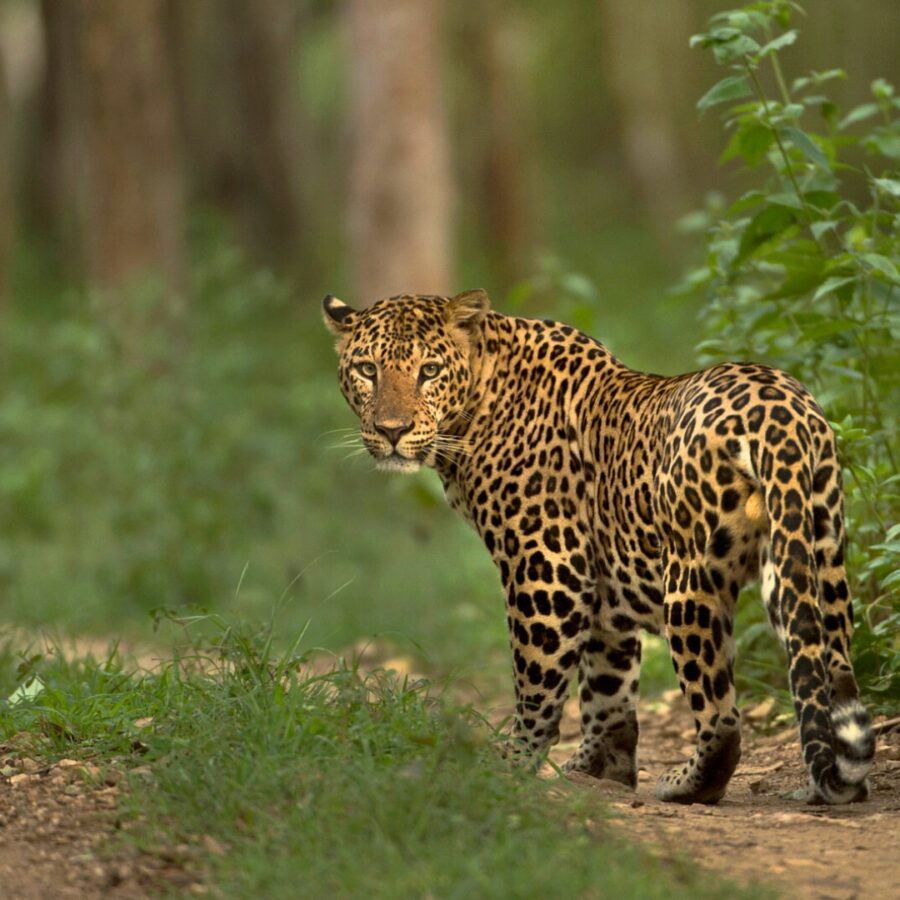
Guides in Nagzira speak, always in hushed tones, of one legendary encounter. It happened years ago, near the fringes of Tiger Trail. A pack of dholes—close to twenty strong—surrounded T2, the tigress known as Mai, and her two young cubs: Jai and Veeru. The wild dogs, relentless in their numbers, attempted to test the boundaries of the queen’s dominion. What happened next is now part of Nagzira folklore. In front of a stunned gypsy full of tourists, Mai is said to have held her ground and killed ten—perhaps twelve—of the wild dogs, one after the other. Silent, calculated, unshaken. The rest scattered into the undergrowth, leaving behind only the echo of their own audacity.
It is this balance—between intelligence and instinct, cooperation and dominance—that defines Nagzira’s dholes. They are seen more often here than in most Indian parks, not by accident, but because Nagzira holds the ecological ingredients they require: prey, space, and a story still unfolding.
In 2016, the Wildlife Institute of India (WII) initiated a pioneering study within the Navegaon-Nagzira Tiger Reserve to investigate the behavior of dholes and their potential impact on tiger movements. This research aimed to understand whether the increasing number of wild dogs influenced tiger dispersal patterns, especially considering notable instances of tigers relocating from the reserve during that period. The study highlighted the complex dynamics between these apex predators and underscored Nagzira’s significance as a habitat where such interactions can be closely observed.
Birding in Nagzira Tiger Reserve
As dawn breaks over Nagzira Wildlife Sanctuary, the forest awakens with a chorus of birdcalls, weaving an intricate tapestry of sounds that herald the new day. This sanctuary, a verdant oasis in central India, is home to over 166 bird species, each contributing to the rich biodiversity that defines this landscape.
In the dappled light beneath the towering sal and teak trees, the Indian Pitta—affectionately termed ‘navrang’ for its vibrant plumage—flits through the underbrush, its distinctive ‘line clear’ call resonating through the morning mist. Nearby, the persistent ‘brain fever’ cry of the Common Hawk-Cuckoo adds a rhythmic undertone to the forest’s melody.
The sanctuary’s diverse habitats, encompassing dense forests, open grasslands, and tranquil water bodies, create ideal conditions for a plethora of avian life. Near Nagzira Lake, the Grey-headed Fish Eagle perches regally, scanning the waters for its next catch, while the Bar-headed Goose, a remarkable migrant from distant Himalayan regions, graces the lake’s surface during winter months.
Among the branches, the Black-hooded Oriole’s striking yellow and black plumage provides a vivid contrast against the green canopy, and the Greater Racket-tailed Drongo, a master mimic, enchants with its varied calls and elaborate tail feathers. The forest floor and lower canopies are alive with the activity of the White-rumped Shama, whose melodious song adds depth to the sanctuary’s acoustic landscape.
As twilight descends, the enigmatic residents of Nagzira emerge—the owls. The Mottled Wood Owl, with its deep, resonant hoots, establishes its presence in the nocturnal soundscape. The Indian Scops Owl, smaller and more elusive, can be spotted nestled within tree hollows, its camouflaged plumage blending seamlessly with the bark. These nocturnal hunters play a crucial role in maintaining the ecological balance, gracefully navigating the night skies in search of prey.
Nagzira’s avian diversity not only enhances the sanctuary’s ecological tapestry but also offers birdwatchers and nature enthusiasts an unparalleled experience. Each visit promises new discoveries, as the sanctuary stands as a living testament to the vibrant and dynamic world of birds.
Nagzira Resort: Staying in Nagzira during your visit
In a forest where the tiger still writes its story into the dust of old trails, the places where humans dwell must remain modest, respectful, and woven gently into the wilderness. Around Nagzira, a handful of thoughtfully positioned camps allow travellers to rest not outside the forest—but within it.
Nagzira Nature Camp
A simple tented camp set just 700 metres from the sanctuary gate. The Swiss tents offer basic but comfortable shelter—attached washrooms, shaded sit-outs, and the sounds of the forest in place of luxury. Quiet, earthy, and close to the action.
Risada Jungle Camp
Positioned near Chorkhamara Gate, Risada offers forest-facing cottages and tents with wide verandahs. Many visitors report hearing alarm calls across the lake at dusk. The location makes it ideal for early safaris and late-evening sightings.
Palash Jungle Resort
Near the Pitezari Gate, Palash is set on 10 acres dotted with palash trees. Accommodations range from fixed tents to deluxe rooms. A good base for those exploring both Nagzira and Nawegaon, without straying far from the forest’s rhythm.
Kanchan’s Homestay
Just minutes from Chorkhamara Gate, Kanchan’s Homestay—run by Kanchana Ramteke, a former sarpanch and recipient of the Prime Minister’s Award—is more than a place to stay; it’s a memory in the making. Humble but comfortable, it was here that we first stayed on our earliest visit to Nagzira.
Meals are a highlight: Kanchan’s legendary country chicken curry, slow-cooked over firewood with spices ground at home, is famous across Gondia district. Served alongside steaming rice and fresh bhakri, it remains one of our favourite meals anywhere in Nagzira.
FAQ
Q: How to reach Nagzira from Nagpur?
A: Nagzira is about 120 km from Nagpur. The nearest entry points—Chorkhamara and Pitezari Gates—can be reached via NH53 toward Sakoli. Taxis or private vehicles are the most convenient options. Nearest railway station: Gondia (45 km).
Q: Does Nagzira have tigers?
A: Yes, Nagzira is home to several wild tigers, including resident females like T4 (Alisha) and her cubs. While sightings depend on luck and timing, tigers are regularly spotted, especially in zones like Tiger Trail and Satmodi.
Q: Is Nagzira a good forest to visit?
A: Absolutely. Nagzira offers a more intimate and less commercialised wildlife experience compared to larger parks. With rich biodiversity, excellent birding, frequent leopard and dhole sightings, and fewer tourists, it’s a hidden gem in central India.
Q: How to book a Nagzira safari?
A: Safaris can be booked online through the official Maharashtra Eco-Tourism website. Choose your gate (Chorkhamara, Pitezari, etc.), vehicle type, and time slot. ID proof is required for booking. Limited spot bookings may be available at the gate.
Conclusion
Nagzira is a forest of texture, not theatre. A place of teak and ain, of bamboo thickets and dry leaf beds that crackle softly beneath the feet of sambar and sloth bear. It does not seek to impress with size, but rather invites you inward—closer to the forest floor, where the wild dog stirs the undergrowth, and a change in birdcall can signal the presence of a predator.
There are no grand avenues here, no dramatic viewpoints. Instead, Nagzira offers a more personal communion with the wild. A leopard glimpsed through the fork of a tree. A tigress pausing by a fading trail. A jungle owlet blinking from a hollow branch.
To walk—or drive—through this forest is to understand that some of India’s most vital wildernesses are also its quietest. In Nagzira, the forest is still learning to trust. And if you arrive with patience and humility, it might just let you in.

